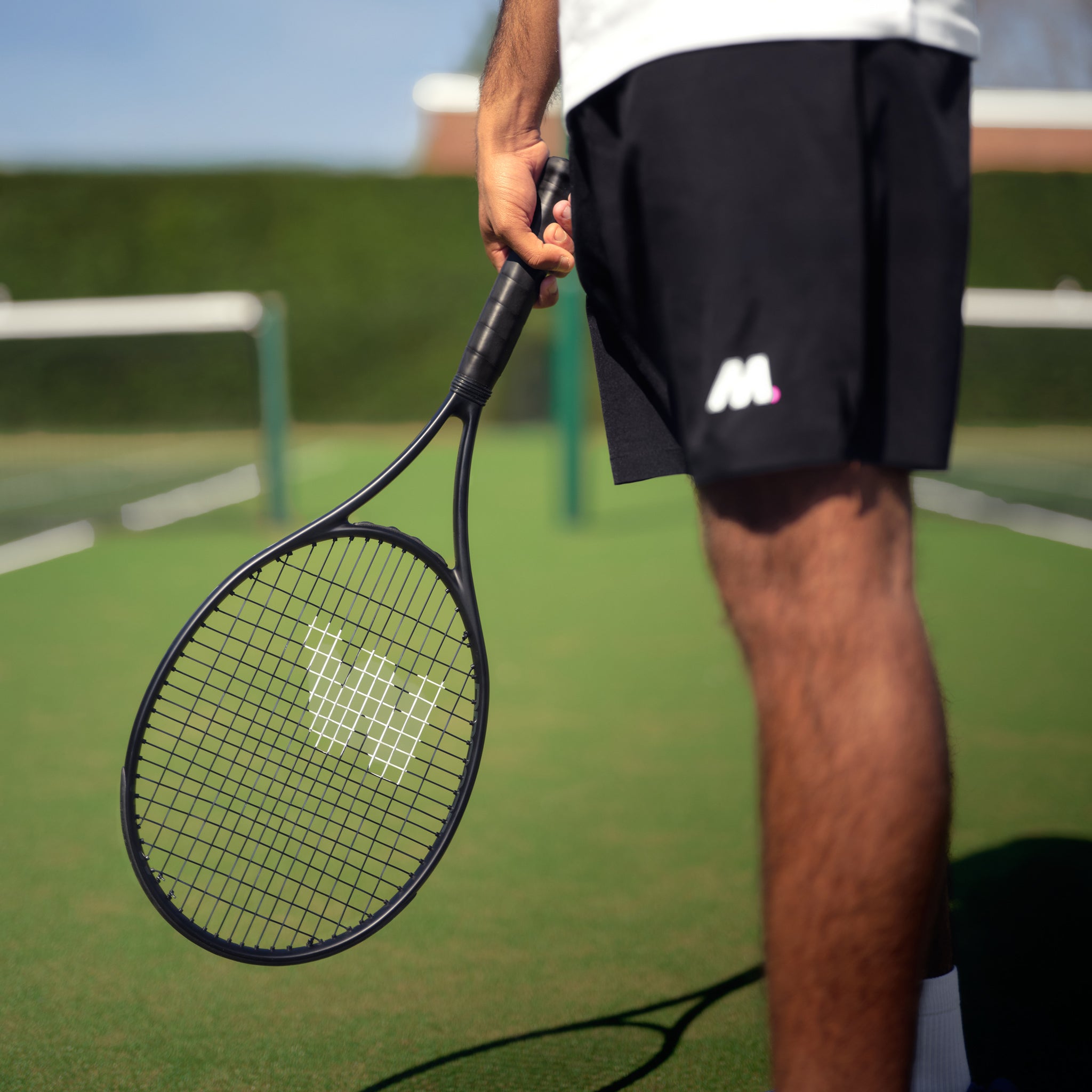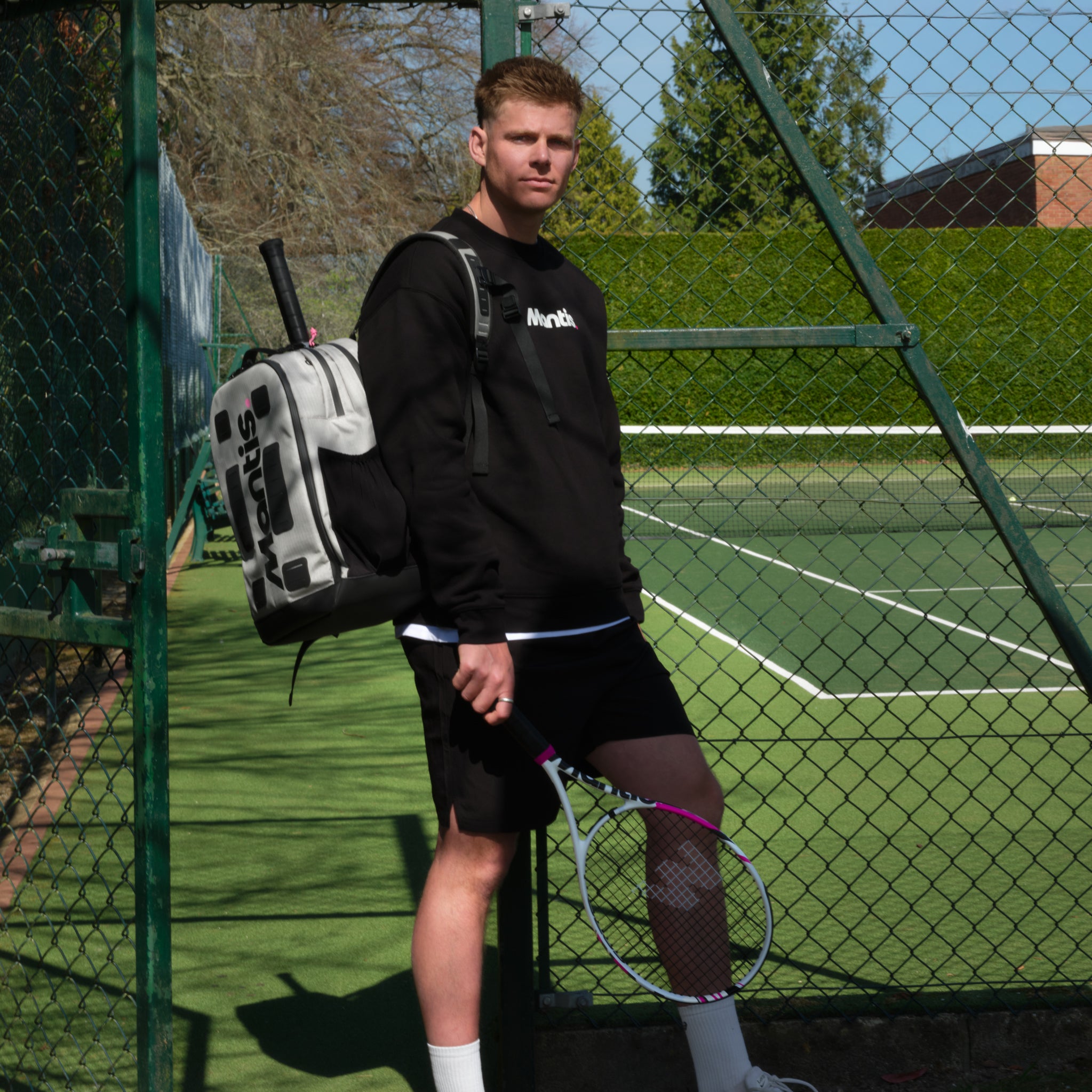
So, you're on the hunt for the best tennis racket for power? It’s a common myth that raw physical strength is all you need to hit heavy shots. The truth is, your racket is a massive part of the equation. A well-chosen frame doesn't just hit the ball; it multiplies the force you put into your swing, turning good shots into blistering winners. That's exactly why Mantis has developed a full lineup of performance rackets designed to do just that.
What makes best tennis racket for power?
In this guide, we're going to pull back the curtain on the real science behind power. We’ll look at how every detail of a racket’s design—from the materials and head size to its weight and balance—can help you tap into your full potential on the court. It’s not about swinging harder; it’s about swinging smarter with the right tool for the job.
We'll build this up step-by-step, starting with some simple physics and then moving on to the specific features that give you a real advantage. Once you grasp the principles of energy transfer and racket design, you’ll be able to see past the marketing hype and choose a racket that truly works for you.
The Science of Amplifying Force
At its core, a powerful racket is an energy-transfer machine. Its job is simple: take the energy from your swing and send as much of it as possible into the tennis ball. When you swing, you create kinetic energy. Your racket is the conduit that channels that energy into the ball at impact. How well it does this comes down to a few key design choices.
These are the critical factors you need to know:
- Head Size: Think of a larger racket head as having a bigger trampoline. It gives you a more generous sweet spot, meaning you get more consistent power even when you don't strike the ball perfectly in the centre.
- Frame Stiffness: A stiffer, more rigid frame bends less when the ball hits it. This is crucial because less bending means less energy is lost in the frame itself, and more is shot straight back into the ball.
- Weight and Balance: A heavier racket, especially one with more weight in the head, has more momentum. This creates a "plough-through" effect that drives through the ball with incredible force, sending it deep into your opponent's court.
- String Pattern: An open string pattern (with more space between the strings) allows the strings to bite into the ball and snap back more dramatically. This creates a catapult effect that can add some serious pop to your shots.
Here at Mantis, we want to share our engineering know-how directly with you. By the end of this guide, you won't just be guessing. You'll understand exactly how to pick a frame that amplifies your game, giving you the confidence to step up and dominate from the baseline.
The Core Physics Behind Racket Power
Before we start comparing specs, let's get to grips with what actually makes a racket powerful. It all comes down to one thing: efficient energy transfer. The energy you generate with your swing needs to be channelled directly into the ball, and a good power racket is simply a tool that does this with as little waste as possible.
Think of it this way: a high-performance racket doesn't magically create power, it preserves it. The design, materials, and balance all team up to stop the force from your swing from fizzling out through frame vibrations or bending on impact. Understanding this simple idea is the key to finding the best tennis racket for power.
It’s no surprise that players are constantly looking for an edge here. The UK tennis and badminton racket market is set to grow annually by around 2.5% in volume and 2.6% in value between 2024 and 2035, largely because players want equipment that helps them hit bigger. You can discover more insights into the UK tennis market trends and see how this demand is pushing racket technology forward.
The Trampoline and The Wall Analogies
To really nail this down, let’s use a couple of simple analogies. These are great for cutting through the technical jargon and getting to the heart of what’s happening in that split second the ball is on your strings.
First, picture your stringbed as a trampoline. When the ball sinks into the strings, they stretch, store that impact energy, and then snap back, launching the ball forward. A great power racket maximises this trampoline effect, ensuring the strings rebound with incredible force.
Next, think of the racket frame as a wall. If you throw a ball against a flimsy garden fence, the fence will wobble and absorb most of the impact, and the ball will just drop. But throw that same ball against a solid brick wall, and it will come flying back at you with nearly all of its original speed.
A stiff, stable racket frame acts just like that solid wall. It barely deforms on impact, so very little energy gets soaked up by the frame. Instead, that energy is fired straight back into the ball. This is precisely why frame stiffness is so crucial for power.
Minimising Energy Loss
At the end of the day, every feature on a power-focused racket is designed to minimise energy loss. A frame that flexes too much loses energy by bending, while one that’s unstable on off-centre hits loses it through twisting and vibrating.
Here’s a quick breakdown of how key racket features fight this energy loss:
- Frame Stability: A stable frame refuses to twist, even when you don't catch the ball perfectly in the centre. This means more of your power makes it into the shot.
- Frame Stiffness: A rigid frame acts like that brick wall we talked about, providing a solid platform that propels the ball forward instead of absorbing the force itself.
Once you understand these fundamental principles, you can look at any racket's specifications and get a real sense of how it will play. It allows you to see past the marketing hype and truly understand what gives a racket its punch. This knowledge is your first and most important step toward finding the perfect frame for your game.
How Head Size and Stiffness Generate Force
Now that we've covered the basic physics of energy transfer, let's zoom in on two of the most critical design choices you'll face when looking for a power-oriented racket: head size and frame stiffness. These two elements are where the magic happens, directly influencing how much energy gets fired back into the ball. Here at Mantis, our engineers are obsessed with getting this balance right, creating frames that deliver explosive yet manageable power.
If you want to do a deeper dive into this specific measurement, our guide on tennis racket head size is a great place to start.
A larger head size—generally anything over 100 square inches—gives you a much bigger target. Think of the stringbed as a trampoline; a larger surface can stretch and rebound more dramatically. This creates a powerful catapult effect, launching the ball off the strings with some serious velocity.
That bigger sweet spot isn't just for show, either. It offers a huge advantage on those inevitable off-centre shots. A larger head is far more stable and forgiving when you don't strike the ball perfectly, so you lose less power and can keep your shots consistent.
The Role of Frame Stiffness
While the head size creates the trampoline, the frame's stiffness determines how much energy the racket itself holds onto. We measure stiffness with an RA (Racket A) rating, where higher numbers mean a more rigid frame. A stiff frame is like the solid brick wall we talked about earlier—it barely bends on impact.
Why is that so important for power? Because minimal flex means the energy from your swing goes directly into the ball instead of getting soaked up and wasted by a bending frame.
For any player chasing easy power, a stiffer frame is your best friend on the court. Look for an RA rating of 70 or higher. This gives you that crisp, solid feel at contact and ensures every ounce of energy is returned to the ball, turning your groundstrokes into genuine weapons.
Finding the Sweet Spot Between Power and Control
Of course, raw power is useless without direction. The trade-off with a huge, stiff racket is often a reduction in feel and precision. A more flexible frame with a smaller head might give a player who relies on touch and placement more feedback and control over the ball.
This simple table breaks down the relationship between these key racket features.
How Head Size and Stiffness Impact Power and Control
| Racket Characteristic | Typical Specification for Power | Primary Benefit | Potential Trade-Off |
|---|---|---|---|
| Head Size | 100+ square inches | Larger sweet spot, more forgiveness, greater "trampoline" effect for easy power. | Reduced precision and feel; can feel unwieldy for some players. |
| Frame Stiffness | 70+ RA Rating | Maximum energy return, crisp and solid feel, directs power into the ball. | Can be harsh on the arm, less ball "pocketing" for touch shots. |
Ultimately, choosing the right racket is all about understanding your own game and finding that perfect balance. At Mantis, we design our rackets to optimise this relationship, giving you powerful frames that don't sacrifice the control you need to dominate the court. The goal is always to find a racket that enhances your natural power without making you feel like you're swinging a club.
Getting to Grips with Weight Balance and Swingweight
The size of a racket's head and its stiffness are big pieces of the power puzzle, but they don't tell the whole story. How a racket’s weight is distributed along the frame is just as important—it’s what really defines how it feels in your hand and, ultimately, how it performs on the court.
Simply knowing the total weight isn't enough. We need to look at balance and swingweight. Understanding these concepts is a game-changer when you're hunting for the best tennis racket for power. If you're starting this journey, our guide on choosing your next racket is a great place to begin.
The Three Flavours of Racket Balance
Think of a racket's balance point as its centre of gravity. Where that point falls determines whether the racket feels heavier in the head or in the handle, and that has a massive impact on everything from stability to swing speed.
Rackets generally fall into one of three camps:
- Head-Heavy: These frames have more of their mass loaded into the hoop. This extra weight at the top helps build momentum as you swing, giving you that satisfying "plough-through" feeling on contact. The result? More stability and deeper, more powerful shots.
- Head-Light: When you shift more weight into the handle, you get a racket that feels quick and easy to whip around. This makes them a favourite for players who generate their own pace and value manoeuvrability for fast reactions at the net.
- Evenly Balanced: No surprises here. These rackets strike a compromise between the two extremes, blending a bit of stability with a dose of manoeuvrability for the all-court player.
If raw, unadulterated power is what you're after, a head-heavy balance is almost always the way to go. It puts more mass directly behind the ball at impact, so the frame is less likely to twist and you can drive through your shots with more authority.
Swingweight: The True Measure of Power
So, balance tells you where the weight is. But swingweight tells you how heavy the racket feels when you actually swing it. It’s the metric that really matters for power, combining the racket's total weight and its balance into one number that describes how much effort it takes to get the frame moving.
Here's a simple analogy: think of swinging a hammer. A regular claw hammer is easy enough to handle. Now, imagine swinging a sledgehammer. It takes a lot more muscle to get it going and to stop it, right? That’s because the sledgehammer has a much higher swingweight.
In tennis, it's the same principle. A higher swingweight means more mass is accelerating into the ball, which translates directly into more power.
A racket with a high swingweight—anything around 325 kg·cm² or higher—will feel solid and substantial as it moves through the air. It won't get pushed around by heavy hitters, and it helps you hit deep, heavy balls from the back of the court almost effortlessly.
Of course, there’s always a trade-off. A really high swingweight can make a racket feel a bit sluggish, making it tougher to react quickly at the net or flick a last-second passing shot. This is where the engineering behind Mantis rackets comes in.
We focus on finding that perfect sweet spot: a high swingweight for commanding power, but without sacrificing so much manoeuvrability that the frame feels like a log. We want to deliver power that feels natural and sustainable, so you can play your aggressive game from the first point to the last without feeling like your arm is about to fall off.
The Real Engine: How Strings and Materials Generate Power
Think of a racket frame as the chassis of a high-performance car. It’s essential, for sure, but the real power comes from the engine—and in tennis, that engine is a dynamic duo of the stringbed and the materials the frame is built from. To truly understand what makes a racket powerful, we need to look past the shape and dive into how these two elements work in harmony.
The materials in today's rackets are light-years ahead of the old wooden frames. If you're curious about that journey, you can get the full story in our guide on tennis racket materials. We now use sophisticated composites like high-modulus graphite and carbon fibre, which are the secret sauce behind modern performance.
What makes these materials so special? They're incredibly strong but also surprisingly light. This allows us at Mantis to build frames that are stiff and stable—the perfect launchpad for powerful shots—without making them feel like a lump of lead to swing.
The Catapult Effect: Understanding String Patterns
One of the most underrated factors in power is the string pattern. You'll generally hear about two types: "open" and "dense." When you're hunting for power, an open pattern is your best friend.
An open pattern, like a 16x19 (that’s 16 main strings running top to bottom and 19 cross strings side to side), has wider gaps between the strings. This extra space lets the strings move more freely and really bite into the ball on impact. As the ball sinks in, the strings stretch back like a slingshot before snapping violently forward.
This ‘snapback’ is what launches the ball off the stringbed with incredible pace and spin. It’s the secret behind that explosive feeling you get from a modern power racket, turning a decent rally ball into a heavy, court-penetrating weapon.
A dense pattern, say an 18x20, does the opposite. It locks the strings down, giving you more control but sacrificing that raw, catapult-like power. It’s no surprise, then, that most rackets designed for big hitting stick with an open string pattern.
The Foundation of Force: Advanced Materials
The science behind racket materials isn't just theory; it has a direct impact on how you play. The UK tennis equipment market, valued at around USD 150 million in 2024, is booming precisely because players are demanding these technological upgrades. Everyone wants lightweight, high-performance gear that delivers more power without sacrificing control.
At Mantis, we are meticulous about the materials we choose, selecting them for very specific jobs:
- High-Modulus Graphite: This is the workhorse. It forms the core of the frame and provides immense stiffness. A rigid frame won't flex or lose energy on impact, meaning more of your power gets transferred directly to the ball.
- Carbon Fibre: We strategically weave carbon fibre into critical areas of the frame to add strength and stability. This stops the racket from twisting when you hit the ball off-centre, so you still get plenty of pop even on mishits.
By carefully blending these advanced composites, we engineer frames that are powerful, solid, and light enough to swing fast. It's this fusion of smart design and material science that you feel on court—the effortless power and the confidence to go for your biggest shots.
How to Choose the Right Mantis Racket for Your Power Game
Alright, we've covered the physics behind what makes a racket powerful. Now for the fun part: putting that theory into practice and finding the right Mantis frame for you.
Choosing the best power racket isn't about grabbing the one with the biggest numbers. It’s about finding a frame whose power characteristics match your swing and your strategy on the court. It needs to feel right—like it was made for you. At Mantis, we design our rackets with specific player styles in mind, so you can find that perfect match.
First things first, you need to know who you are as a player. Do you live on the baseline, crushing heavy topspin groundstrokes until your opponent gives up? Or are you an all-court attacker, using a massive serve to set up a finishing volley at the net? Let's break down our range and see which Mantis racket aligns with your game.
For the Aggressive Baseliner
If your game is all about relentless pressure from the back of the court, you're an aggressive baseliner. You win points by hitting deep, heavy shots that pin your opponent behind their own baseline, just waiting for them to drop one short so you can pounce. Your racket is your primary weapon, and it needs to be stable, powerful, and ready to do some of the heavy lifting.
For this kind of game, you’ll want to look at Mantis rackets with these traits:
- Larger Head Size (100+ sq. in.): This gives you a bigger sweet spot and more forgiveness, making it easier to generate blistering pace on your groundstrokes.
- Stiff Frame (70+ RA): A high stiffness rating means less energy is lost when the racket bends. Instead, that energy is transferred directly to the ball, making it rocket off your strings.
- Head-Heavy Balance: With more weight in the hoop, the racket naturally ploughs through the ball, adding serious mass and stability to your shots.
A racket with these specs feels rock-solid on contact. It’s built to amplify your long, fluid swings and help you hit punishingly deep balls, rally after rally.
For the All-Court Power Player
The all-court player is a master of versatility. Your game is built around a big serve that puts you in control from the very first shot, and you're always looking for a chance to move forward and end the point with a crisp volley.
You need a racket that can do it all: deliver raw power from the baseline but also offer enough feel and manoeuvrability for quick reactions at the net. We’ve engineered specific Mantis frames with a different recipe for this dynamic style:
- Mid-Plus Head Size (98-100 sq. in.): This size is the sweet spot for blending power with control, giving you the confidence to hit big targets from anywhere on the court.
- Moderate Stiffness (65-70 RA): This gives you plenty of pop for serves and groundies, but with enough flex to provide the touch you need for delicate volleys or drop shots.
- Even to Slightly Head-Light Balance: By shifting the balance point, we make the racket easier to swing fast for explosive serves and quicker to get into position for net play.
When you match a racket’s DNA to your playing style, you can step onto the court with total confidence. Our mission is to give you the perfect tool to unlock your potential and truly command the game, your way.
Got Questions? Let's Talk Power Rackets
Choosing a racket is a big decision, so it's natural to have a few questions left. We've pulled together some of the most common things players ask when looking for a frame that packs a punch. Think of this as a final chat with a coach to clear up any lingering doubts before you commit. After all, picking the right gear is the first step to playing your best tennis, and we're here to help you get it right.
Can Strings Really Make That Much Difference to Power?
You bet they can. In fact, strings are a massive part of the power equation. Think of your stringbed as a trampoline; a more elastic string, like a multifilament or natural gut, will give you a much bigger bounce, sending the ball flying with more speed.
Another trick is to lower your string tension. This lets the strings stretch further on impact, soaking up energy before firing it back into the ball. It's a simple tweak that can add noticeable pop to your shots, though you might trade a little bit of control for it.
So, a Heavier Racket Means More Power, Right?
In theory, yes, but it's not quite that simple. A heavier racket has more mass to throw behind the ball, creating better stability and that satisfying "plough-through" feeling on contact. That’s why swingweight is often a better stat to look at than just the static weight.
But here’s the catch: you have to be able to swing it. If a racket is too heavy for you, your swing will slow down, and you'll actually lose power. Not only that, but you'll get tired faster and risk injury. The sweet spot is finding the heaviest frame you can swing efficiently for a full match.
Are Power Rackets Bad for Your Arm?
They can be if you choose the wrong one. Rackets built for power are often much stiffer, and that stiffness means more of the impact shock travels straight up your arm. A really stiff frame (think an RA rating of 70+) paired with a firm polyester string can be a recipe for discomfort, especially if you're prone to tennis elbow.
For players worried about arm-friendliness, we always suggest looking for a racket with a more moderate stiffness rating (below 70 RA). Another great option is to pair a stiffer frame with a soft, arm-friendly string, like a multifilament, to cushion the blow. This way, you can get the power without the punishment.
How Do I Know if a Power Racket Is What I Need?
A power-focused racket is a fantastic tool for players who have shorter, more compact swings and need some help generating depth and pace. If you feel like you're doing everything right but your shots keep dropping short in the court, or you struggle to hit clean winners from the baseline, a power frame could completely change your game.
On the other hand, if you’re already a big hitter but find your shots flying long, you’d probably be better off with a racket that offers more control. The goal is to find a frame that complements your natural game, not fight against it.
At Mantis, we build rackets for players who are passionate about improving. See how our frames deliver that perfect blend of power and precision by exploring the full range at https://mantissport.com.








